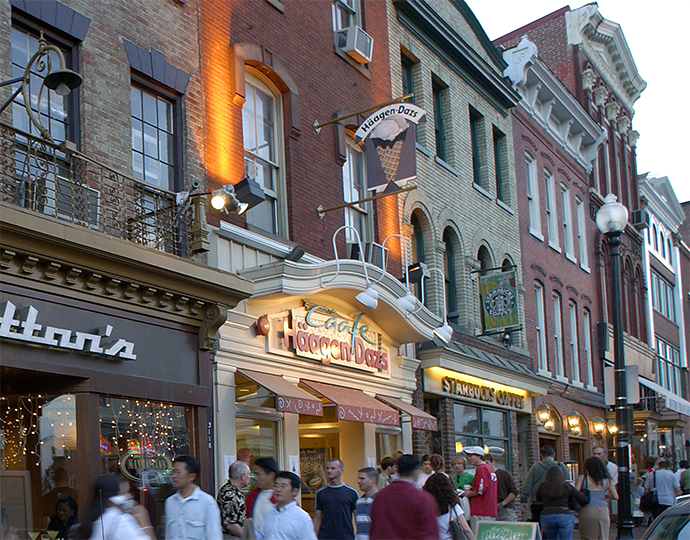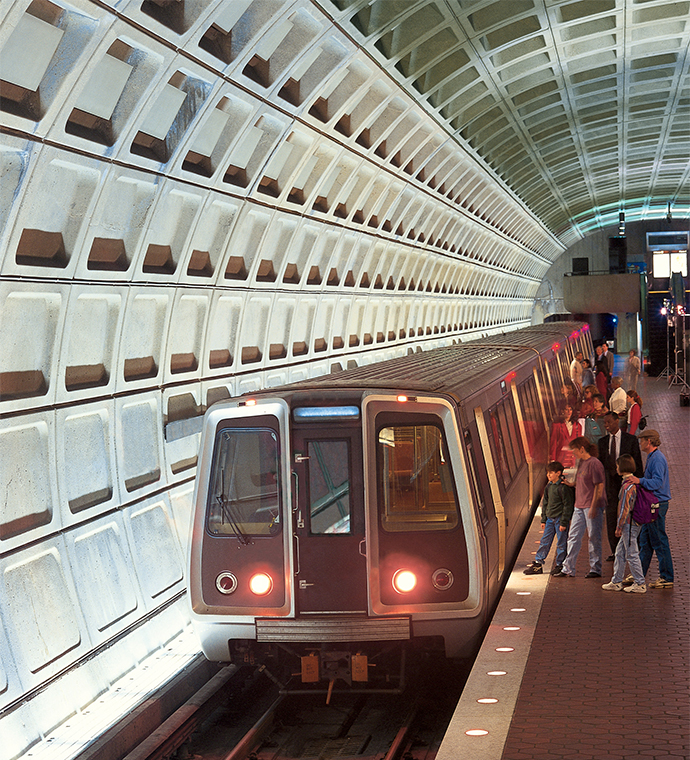
Don’t worry: All those garages, maker spaces, converted warehouses and mixed-use projects in the center city are still as hip as ever, and still attracting talent, diversity and business locations.
The sleepy suburbs, however, may not be as unhip and marooned as you think.
Earlier this week, LOCUS, a program of Smart Growth America, released “Foot Traffic Ahead: Ranking Walkable Urbanism in America’s 30 Largest Metros,” ranking the country’s 30 largest metropolitan areas by population on a continuum from most to least amount of walkable urban development. The report also includes a series of forward-looking metrics examining future development patterns in these metro areas to predict how walkable or how sprawling their future development is likely to be.
Six cities topped the rankings (full chart below) because of their “high walkable urbanism”: Washington, DC; New York; Boston; San Francisco; Chicago and Seattle. The least walkable among the 30 were Tampa, Phoenix and, in last place, Orlando.
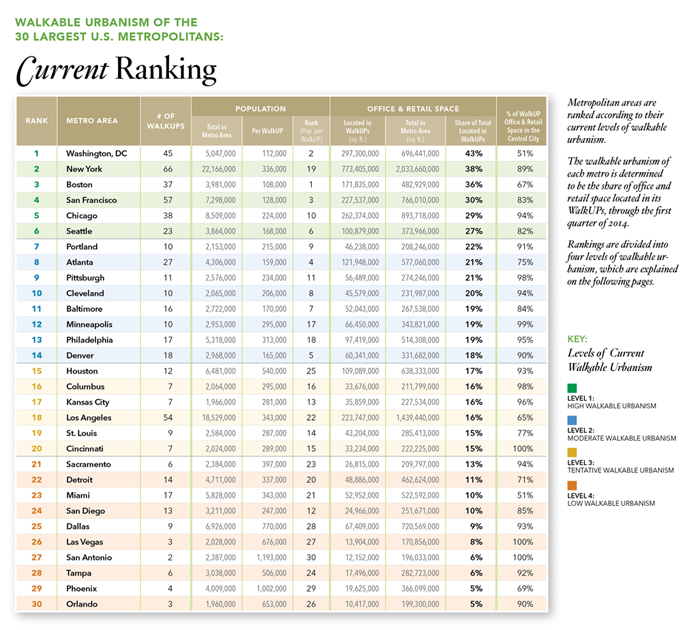
As for DC, the report states: “Analysis of metro Wash¬ington, DC, in 2012 identified 45 WalkUPs that on average occupy 408 acres each — or approximately 17,500 acres in total. In the current real estate cycle, which began in 2009, these WalkUPs, which make up less than 1 percent of the metro area’s acreage, have accounted for 48 percent of the metro area’s new office, hotel, and rental apartment square footage.”
Among the report’s highlights:
- A total of 558 walkable places (WalkUps) exist in the 30 metros, containing 22 percent of the total office and retail space in these metros. Forty-two of the WalkUPs identified were in the suburbs, though they account for only about 20 percent of the office and retail space in WalkUPs. The study only evaluated WalkUPs of regional significance, defined as having at least 340,000 sq. ft. of retail or 1.4 million sq. ft. of office space.
- The high-ranking metro areas have an average of 39 percent of their population over 25 years of age who are college graduates (substantially higher than the 29 percent of the lower-ranking metros). The high-ranking metros also have an average of 38 percent higher GDP per capita as compared to the low-ranking metros.
- Research, observations, and in-depth analysis of metro Atlanta, Boston, and Washington, DC, suggest that WalkUPs account for about 1 percent of all metropolitan land in the 30 largest metros.
- In urban WalkUPs, office rent-per-sq.-ft. premiums are 74 percent over rents in “drivable sub-urban” areas, i.e. the stereotypical suburb only reachable and navigable by car, with different property types segregated from one another.
But evidence is building that belies that stereotype. New York nabs second place because of the sheer volume of WalkUPs in Manhattan alone. One reason DC and Boston rank first and third is the urbanization of its suburbs. DC, says the report, “not only has the most office and retail in WalkUPs, but also has the most balanced distribution of walkable urban space between the central city (51 percent) and suburbs (49 percent) … Metro Boston, ranked third, experienced urbanization of its suburbs, primarily Cambridge, which contributed to its high ranking.”
Moderate to Tentative to Stranded
The eight cities with moderate walkable urbanism come next, led by Portland, Ore., Atlanta and Pittsburgh. Portland is called out for not yet spreading its “Portlandia”-style walkable urbanism beyond the central city.
“Among these moderately ranked metros, Minne¬apolis and Denver are noteworthy,” says the report. “While most current walkable urbanism is in their central cities, both areas are significantly expanding their light rail systems and the potential of suburban urbanism.”
The next group of six cities with “Tentative Walkable Urbanism” are led by Houston, Columbus and Kansas City, which together with fellow “tentative” city Cincinnati have 93 percent or more of their walkable urban office and retail space in the central city.
“Los Angeles and St. Louis demonstrate strong walkable urbanism in their suburbs, and both metros are aggressively expanding their rail transit systems,” says the report, noting LA’s huge rail transit expansion project.
The lowest walkability category captures the remaining 10 cities, which have low percentages of walkable space, and most of what does exist in the center city. However, even in these unwalkable places there are places where the sidewalk begins.
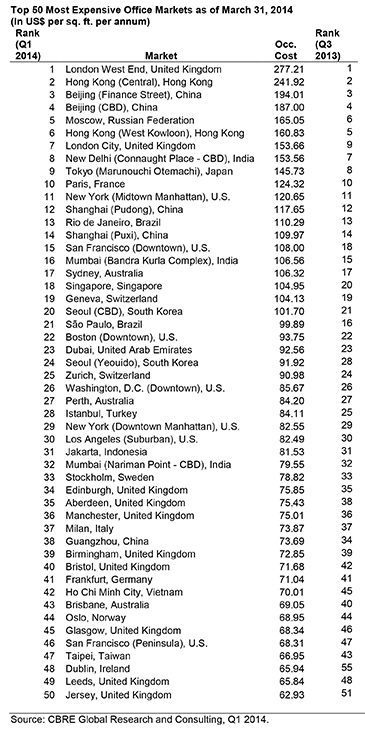
“Historically, drivable sub-urban development has characterized metro Detroit, Miami, and Phoenix,” says the report. “However, in contrast to their popular reputations and low rankings at present, all three metros are experiencing revitalized downtowns and even some urbanizing suburbs, with several outstanding exam¬ples of WalkUPs in them,” among them places such as the Detroit suburb of Birmingham, Mich., which commands the highest rents per sq. ft. in the region in part because it’s a balanced blend of suburbia and urbanism.
The Frontier is Here
At a press conference this week, the report’s primary author Christopher Leinberger, president, LOCUS: Responsible Real Estate Developers and Investors and chair of the Center for Real Estate and Urban Analysis George Washington University School of Business said the 74-percent price premiums indicate pent-up demand that is large and increasing.
“We conclude that the top-ranked metro regions are witnessing the end of sprawl,” he said, saying it’s a change as significant as when historian Frederick Jackson Turner declared in 1893 at the World’s Columbian Exposition in Chicago that “the frontier has gone.”
“I think this is a pretty significant change in how we build the country,” said Leinberger. “We think there will be demand for tens of millions of square feet of additional walkable urban development.”
He even goes so far as to attribute some of the drop in greenhouse gas emissions to the trend.
“Ninety percent of the climate change conversation is on the technical supply side, trying to make resources more efficient,” he said, noting his own family’s in-town location and barely driven automobile. “When you take a drivable sub-urban household and move it into a walkable space, you drop emissions anywhere from 50 to 80 percent. I think it is a factor in why greenhouse gas emissions are down by 10 percent.”
If emissions and long commutes are going down, transit-oriented projects are what’s going up.
“We currently have about 60 projects in some phase of planning or construction, almost exclusively in transit-oriented development,” said Rod Lawrence, partner at developer JBG Companies. That doesn’t mean it’s been an easy sell. Getting zoning and infrastructure changed to allow for such development has been a challenge, with it taking “five to 10 years in some areas just to get the zoning change,” he said.
Times are changing, however, with NIMBYs once staunchly opposed to any development “now saying ‘How can we get more of this?’” said Lawrence, noting that office tenants are seeking such projects too. Political leaders like it as well, as an efficient model for growth that helps jurisdictions increase the tax base while also getting more out of their infrastructure.
“A recent study by Wisconsin PIRG finds that more than 80 percent of college students think having transportation options other than driving was either somewhat or very important in where they choose to live.”
Emerick Corsi, president, Forest City Enterprises Real Estate Services, added, “In some cases, eight to 10 years is a short time period to get these projects completed,” and public-private partnerships are essential to success. His team prefers project sites “on top of, adjacent to or in between train stations, with a quarter-mile walk.” When they get close enough, the price premiums do indeed follow: “You’re seeing 50 to 74 and in some cases 80 percent on the premium,” he said.
New Q1 2014 rankings from CBRE of the 50 most expensive office markets worldwide bear out Leinberger’s assertion that walkability corresponds to being able to charge premium rents. No. 1 WalkUP DC is the world’s 26th most expensive prime office parket, at $85.67 annually per sq. ft. No. 2 New York is 11th at $120.65. No. 3 Boston is 22nd at $93.75 and No. 4 San Francisco is 15th at $108. Seattle, which has the nation’s 6th best walkability among its top 30 cities, has seen its suburban market’s office costs rise the second most of any of the most expensive cities in the world, at 19.4 percent year over year, with San Francisco not far behind. (See chart below.)
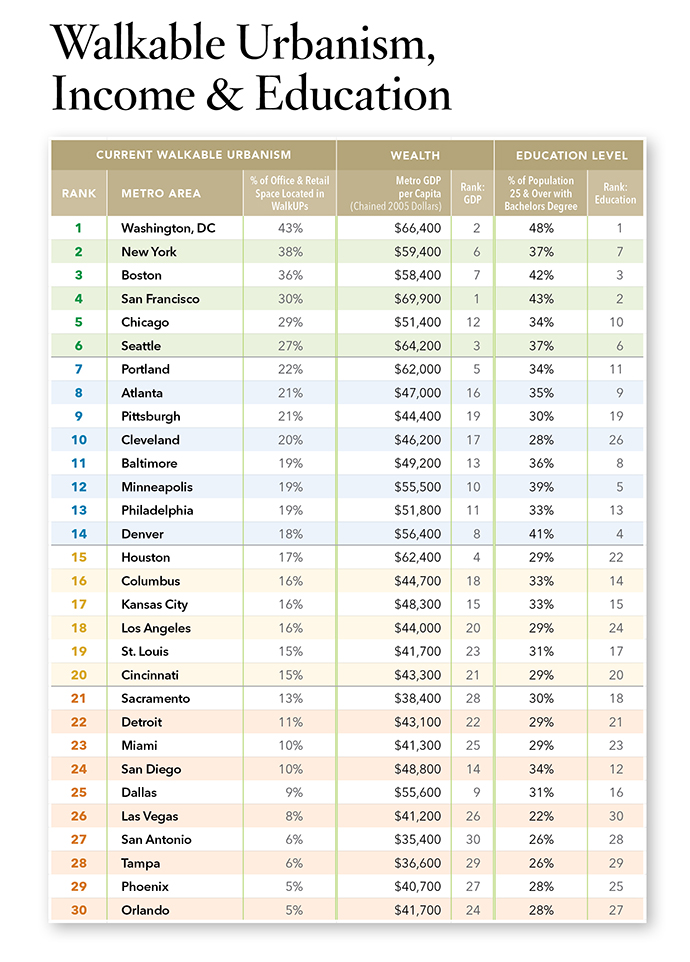
Too Fabulous
The missing piece is affordable housing in or near cities’ central business districts. Leinberger said a number of tools exist to facilitate such development, but Corsi said the political will can be lacking. Pure cost keeps rearing its head too.
“Prices are way out of line in the CBDs with what it is in the suburbs — $1 millinon in year one and $1.5 million in year two,” said Lawrence. “Before you even start breaking ground, you have lobbyists, architecture, and you have to hire all kinds of others — you’re going to spend at least $12 million to $15 million. Then the city wants to put on top of that ‘We want iconic.’ To do that, you’re going to hire the best architects in the world. Then you say, “Oh my God.” So you have a lot of cost in there, and without the public recognizing that a developer doesn’t always have as deep a pockets as they are perceived to have.” Sometimes, he said, when he’s told for the umpteenth time how much money he made on a project, “I want to give them the keys to it, because we are not making money.”
“Smart Growth America and LOCUS, a well as George Washington University, JBG and Forest City, are pushing forward with a very comprehensive model project to create an affordable housing strategy that is place-based over the next year,” added Leinberger. “We think it should be developer driven.”
Among the admitted weaknesses in the study’s methodology is the omission of owner-user space, i.e. employment space occupied by its owners. “Many public and private sector organizations occupy their own real estate,” the report states. “For example, federal and state governments, and universities and medical centers tend to be owner-occupied. Because no comprehensive regional or national database exists for these real estate types, as much as 30 to 40 percent of employment space cannot be classified and therefore measured. This omission represents a gap in all studies of development patterns, including this one.”
Getting There
Dallas (No. 25 out of the nation’s biggest 30 metros) and Phoenix (No. 29) may be near the bottom in overall walkability today. But live-work-play environments such as those from KDC in the Dallas suburbs of Richardson and Plano (left), Ryan Companies in Tempe (middle) and DMB Associates at Eastmark in Mesa (right) have helped attract major corporate campuses from the likes of State Farm, Tyler Technologies and Apple, among others.
Suburban urbanized developments such as these may be one reason the future rankings of walkable urbanism place Dallas nine spots higher at No. 17, and Phoenix 17 spots higher at No. 12. According to the “Foot Traffic Ahead” report, Detroit is among the other cities showing the most promise for improved walkability in the future. And Orlando is poised to jump from last place to No. 18.

While square footage is not tallied up, Site Selection annually recognizes the nation’s top metro areas for corporate facility location and expansion investment, measured by capital invested and jobs created according to minimum criteria of $1 million or 50 new jobs. Correlation with WalkUP leaders is spotty at best: Top Metro No. 1 Chicago was third in the report’s rankings, No. 2 Houston was 15th, and No. 3 Dallas was 25th, followed by No. 4 Atlanta in 8th, No. 5 Detroit in 22nd, No. 6 Cincinnati in 20th, No. 7 Kansas City in 17th, No. 8 Columbus in 16th, No. 9 Philadelphia in 13th and No. 10 New York in second place for walkability.
Corroboration by Coincidence
Two white papers from CBRE released a week apart earlier this month enter the cities vs. suburbs fray and come out on Leinberger’s side in breaking apart old preconceptions. Glen Costello, managing director, Americas Research – Investment Research at CBRE, asked in a June 2 paper, “Is the hullabaloo over the death of suburbs in the US — and the death of the suburban office market in particular — overblown? Certain demographic shifts that are under way suggest that suburban investments have legs.”
“It is a generally accepted reality in the US that suburbs are boring,” he writes, and so millennials are assumed to be running for the skyscrapers as soon as they can. Firms looking to hire those new workers have followed, he says, but it would be a mistake to call this shift permanent. That’s because since 2012, suburban net absorption of office space has outpaced downtown. Some of that is directly related to a rise in home prices and home construction he says. “More fundamentally, though, this idea that the U.S. might resettle into urban environments is turning out to be more complex than death-of-the-suburbs proponents might have imagined,” he writes. “Suburbs are more than just lighted streets and quiet nights. They are a technological achievement precipitated by innovations in transport.”
Those innovations caused the suburbs to sprout in the first place, with companies chasing them to those outlying areas. “Today, firms are chasing those workers’ grandchildren and great grandchildren in urban areas, but rising home prices and low interest rates now favor ownership over renting, and some are moving back the other way,” writes Costello. One possible result of working concepts such as Google’s self-driving car could be less stress in commuting, meaning more people would consider suburban locations.
“If innovation by businesses in the US continues to be rewarded, some of the technologies now under development are likely to further bolster demand in these locations,” he writes. “Still, urban areas are often now sprawling entities with multiple nodes that one might call ‘downtowns.’ New and emerging technologies may further blur the lines.”
Gleb Nechayev, senior managing economist, CBRE Econometric Advisors, says in a June 9 commentary that close study of US Census figures show “more Millennials live in suburbs than in cities, and that in many metro areas, the share of Millennials living in suburbs continues to edge higher.” This graph tells all:
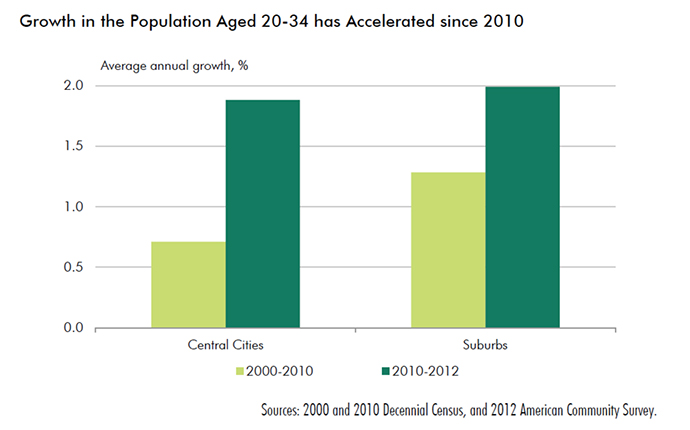
His conclusion circles back to the future challenge raised by Leinberger:
“It could well be that if more affordable housing becomes available in central cities, the preference towards living there might increase; so far, though, much of the new residential development in cities is luxury, targeting a relatively small share of high-income Millennials. Meanwhile, there are still more Millennials living in the suburbs—and one should not overlook this rapidly-growing segment of housing demand. In most major metro areas around the country, there are still no signs of exodus of young people from the suburbs — it’s just the opposite!”
